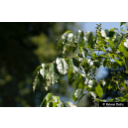Wissenswertes zu diesem Pflanzenindivuduum
Prunus serotina Ehrh. 1784
Rosaceae
- Rosengewächse (APG IV)Späte Traubenkirsche, Herbstkirsche, Späte Trauben-Kirsche
Akzessionnummer: LG-W-002-13897
Pflanzjahr: 1998
Patenschaftstext: Für Magdalene Straile z. Geburtstag
Taxonkonzept: The Plant List (2010)
Verbreitung: östl. Kanada; USA: Nordosten, Nordost-Zentral, nördl. und südl. Prärie-Staaten, Südwesten, Südosten, Florida; Mexiko, Guatemala; eingebürgert in Europa
Größe: 0 (m)Blütezeit: V - VI
Prunus serotina Poir. - Synonym: Prunus serotina Ehrh. bei Zander 2008; Familie: Rosaceae (Zander 2008)Prunus serotina Ehrh. - Accepted: Prunus serotina Ehrh. bei The Plant List (2010); Familie: Rosaceae (APG III)Prunus serotina Ehrh. - Accepted: Prunus serotina Ehrh. bei Zander 2008; Familie: Rosaceae (Zander 2008)Prunus serotina Ehrh. - Accepted: Prunus serotina Ehrh. bei The Plant List (2014), version 1.1; Familie: Rosaceae (APG III)Prunus serotina Ehrh. - Accepted: Prunus serotina Ehrh. bei The Plant List (2014), version 1.1; Familie: Rosaceae (APG IV)Prunus serotina Ehrh. - Accepted: Prunus serotina Ehrh. bei BfN Checklist Flora DE; Familie: Rosaceae (APG IV)
- Schutzstatus, Rote Liste
- Ungefährdet in DE (*)
- Lebensform
- holzig, Baum
- Kommentar zur Ökologie
- ziemlich häufig als Zierbaum oder forstlich eineingebracht, als Nutz- oder Bodenschutz-Holz. Zum Teil verwildert in stadtnahen Waldges. oder Calluna-Heiden
- Vegetationstypus und Synökologie (Pflanzengesellschaft)
- Status der Einbürgerung
- Neophyt; ziemlich häufig als Zierbaum oder forstlich eingebracht, Status nach BfN: N = etablierte Neobiota
- Gefährdungspotential des eingewanderten Taxons in der Region
- invasiv; verdrängt einheimische Arten, nach BfN: invasiv
- Nektar
- mittel bis sehr gut
- Pollen
- wenig bis gut
Bundesamt für Naturschutz (BfN) (1999-2001 and ongoing): Floraweb - Daten und Informationen zu Wildpflanzen und zur Vegetation Deutschlands. www.floraweb.de.; Erhardt, W., Götz, E., Bödeker, N. & Seybold, S. (2008): Der große Zander. Enzyklopädie der Pflanzennamen. Band 2. Arten und Sorten. Eugen Ulmer KG, Stuttgart (Hohenheim), 18. Aufl., 2103 S.; Oberdorfer, E. (2001): Pflanzensoziologische Exkursionsflora. Für Deutschland und angrenzende Gebiete. Eugen Ulmer Verlag, Stuttgart, 8., stark überarb. u. erg. Aufl, 1056 S. 978-3-8001-3131-0.; Pritsch, Günter et al. (1985): Bienenweide.. Neumann-Neudamm, Melsungen; Pritsch, Günter et al. (2007): 200 Trachtpflanzen erkennen und bewerten.. Kosmos, Stuttgart; Schick, B. & Spürgin, A. (1997): Die Bienenweide. Eugen Ulmer Verlag, Stuttgart, Auflage: 4., völlig neubearb. u. erw. A., 216 S. 978-3800174188.; The International Plant Names Index (2009). Published on the Internet http://www.ipni.org; Courtesy to IPNI, 2009. Exported from IPNI at date: 2009-09-22 20:17:51;
Diese Webseite verwendet Google Maps, um Karten und Standorte von Pflanzen in den Hohenheimer Gärten anzuzeigen. Dadurch werden unter Umständen Daten an Google weitergeleitet, was mit einer Verarbeitung Ihrer personenbezogenen Daten verbunden sein kann. Die Datenschutzerklärung von Google finden Sie hier: Datenschutzerklärung von Google


